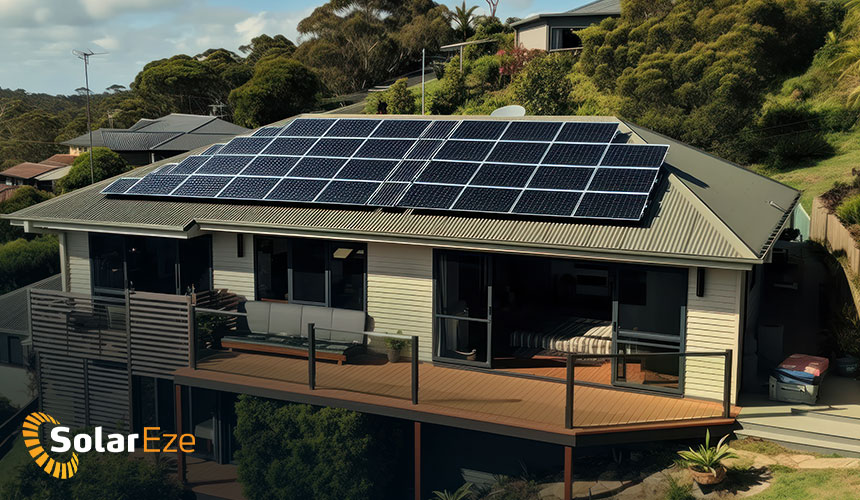How much power will a 6.6 kW solar system produce?
Discover how much power will a 6.6 kW solar system produce, and how it can revolutionise your energy consumption.
15+ Years Experience
Financing Available
10 Years Warranty
CEC Qualified Installers
You’re considering a 6.6kW solar system for your home, but you’re unsure about its power output, right? We’ll guide you through how much electricity it can generate and the factors that can affect its production.
With this knowledge, you’ll be able to make an informed decision about whether this system size is suitable for your energy needs.
Key Takeaways
- Solar systems are rated in watts or kilowatts, and a 6.6kW system is a recommended minimum size for covering household consumption.
- A larger system size of 8-10kW or more is becoming common, especially when combined with a storage battery.
- The actual electricity generation of a solar system depends on factors such as location, sunlight availability, system quality, panel orientation, and age.
- It is important to consult with solar installers to determine the appropriate system size and to choose quality solar panels and inverters that match the size of the solar system.
- On average you can expect about 26.4KWh of power to be generated per day by a 6.6kW solar system.
Understanding the Basics of Electricity Usage
You’ll need to consider not only your current electricity usage but also the potential fluctuations throughout the day and across different seasons. It’s important to remember that solar production varies depending on these factors, so understanding your consumption patterns can help you maximise the efficiency of your 6.6kW solar system.
Additionally, don’t forget to anticipate future usage—whether it’s due to lifestyle changes or adding new appliances—as this will play a crucial role in determining if your system will remain sufficient for your needs down the line.
Time of day and seasonal usage
It’s crucial to consider the time of day and seasonal variations in electricity usage when calculating how much power a 6.6kW solar system will produce. Your current and future energy needs, grid reliability, and the efficiency of your solar panels all play a role in this.
- Seasonal variations: Sunlight duration varies with seasons impacting energy generation.
- Future energy needs: Account for potential increases in your power consumption.
- Solar panel efficiency: Not all panels are created equal; efficiency can impact output.
- Grid reliability: If you’re connected to the grid, its reliability matters.
Understanding these factors is key to optimising your system’s performance. But remember, it’s also important to plan for future usage scenarios.
Future usage
Anticipating any potential increases in your home’s electricity needs is a crucial step when sizing up for a solar installation. Future upgrades, such as electric vehicles or smart appliances, could increase your energy consumption significantly. It’s important to account for these changes so you’re not left with an underperforming system down the line.
Consider incorporating a solar battery into your system. This will allow you to store excess power generated during the day and use it when needed. Plus, improving solar panel efficiency means more energy production from the same amount of sunlight.
Remember that government incentives are available to help offset some costs of installing renewable energy systems. These can make larger installations with advanced features like storage more affordable. Planning for future needs ensures you’ll reap maximum benefits from your investment long-term.
Deciding the Size of Your Solar System
Deciding on the size of your solar system is crucial as a 6.6kW system, for instance, will generate approximately 26.4kWh of electricity per day under ideal conditions. This decision directly impacts your energy savings and return on investment (ROI).
To begin with, understanding solar efficiency is key to optimising the performance of your system. The capacity of a solar panel to convert sunlight into electricity determines its efficiency level. High-efficiency panels tend to be more expensive but they’re also more productive.
Calculating energy savings involves determining how much electricity you can offset with solar power versus what you’d normally pay for grid electricity. It’s worth noting that while larger systems produce more power, they also cost more initially.
When it comes to maximising ROI, you need to balance the upfront costs against long-term savings. A well-sized system can pay back its initial investment over time through lower electricity bills.
Integrating storage solutions like batteries can also optimise your system’s performance by storing excess power generated during the day for use at night or on cloudy days.
Consider these points:
- Assess your average daily and seasonal energy consumption.
- Factor in potential changes in future usage.
- Take into account available roof space and orientation towards the sun.
- Consider local regulations regarding solar installations.
- Consult with reputable solar installers for tailored advice.
Comparing Grid-Connected and Off-Grid Systems
As you delve further into the world of solar systems, you’ll encounter two primary types: Grid-Connected and Off-Grid Systems. The former is a more common arrangement where your system is linked with the central power grid, supplying power during the day while drawing from the grid when sunlight is low. On the other hand, an off-grid system operates independently from the main power grid and requires sufficient battery storage for periods without sunlight – a setup that demands careful planning and higher initial costs.
Grid-Connected System
You’re likely to choose a grid-connected system, which is the most common type and offers power during the day from your solar panels, and power at night or on low-sunlight days from the grid. This system’s reliability depends heavily on the stability of your local grid, which can be affected by environmental factors and infrastructure upkeep.
Key considerations for this setup include:
- Inverter selection: Ensure you have an appropriately sized inverter that can handle your energy generation.
- Battery integration: A battery storage solution may increase system costs but provides backup power during outages.
- Grid reliability: Investigate how often your area experiences blackouts or brownouts.
- System cost: Factor in all costs including your solar installation, maintenance, and potential upgrades.
- Council laws: Check if there are any rules or restrictions impacting solar panel installations in your city.
Off-Grid System
As you transition from understanding grid-connected systems, it’s essential to delve into the intricacies of an off-grid system.
Unlike its counterpart, an off-grid system operates independently from the power grid. It necessitates robust battery requirements, as all your power needs have to be met by the stored energy. The costs involved are higher due to these added storage capacities and complex installations.
An off-grid system demands regular maintenance checks for optimal performance and reliability, ensuring an uninterrupted power supply. Despite these factors, it affords a high level of efficiency since it eliminates dependence on fluctuating utility rates and grid outages.
Now that you’ve got a grasp on these elements, let’s move on to examining key factors to consider during installation.
Key Factors to Consider During Installation
As you move forward with your solar panel installation, there are several key factors to consider that will greatly impact the efficiency of your system. You’ll need to assess the available roof space on your property, as this will determine the size and number of panels you can install.
Additionally, take into account any potential shading from surrounding structures or foliage which may decrease panel productivity, and finally, ensure careful consideration is given to the orientation of your panels – in the Southern hemisphere for instance, a north-facing position typically yields optimal results.
Roof space
It’s crucial to evaluate your available roof space before installing a 6.6kW solar system, as it needs sufficient area for optimal performance. Not only does the size of your roof matter but its orientation and shading can significantly impact solar panel efficiency.
Consider these aspects:
- The need for ample unshaded space for sunlight to reach the panels.
- Your roof’s orientation, ideal is north-facing in the southern hemisphere.
- Obstacles like pipes or antennas could obstruct installation.
- Potential expansion if you plan to add more panels later.
- Local regulations and permits are required for installation.
Shading
You’ve got to remember, shading can significantly impact the efficiency of your panels. To maximise efficiency, it’s crucial that you optimise sunlight access by appropriately placing your panels. Trees, nearby buildings, chimneys – all could potentially cast a shadow on your system and lead to minimised energy production.
Consider shading solutions such as trimming overhanging branches or even relocating the system if feasible. Use tools like a Solar Pathfinder or SunEye to analyse potential shading issues throughout the year. This will assist in determining the optimal panel placement ensuring maximising output from your 6.6kW solar system.
Orientation
Panel orientation is essential in harnessing the most energy from the sun. The direction your panels face can significantly impact system efficiency and therefore, the amount of electricity generated. Here’s what you need to consider:
- Panel direction: Ideally, you should aim for a south-facing direction if you’re in the northern hemisphere, or north if you’re down south.
- Sunlight availability: Your location will determine how much sunlight your panels can soak up throughout the day.
- System efficiency: Regular maintenance ensures that your system operates at peak performance.
- Age of panels: Over time, solar panels become less efficient. Consider this when calculating potential output.
- Location: Geographic location plays a role too, as different areas receive varying amounts of sunlight.
Engaging with Solar Installers
When you’re ready to determine the exact power output of a 6.6kW solar system for your home, consult with a highly reviewed solar installer like SolarEze who can provide detailed quotes based on your specific energy usage and roof space. Experts like us will guide you through the process, taking into account crucial factors like maximising efficiency, potential savings, maintenance requirements, and government incentives.
The goal of maximising efficiency involves several aspects. First is ensuring optimal panel placement and orientation to capture maximum sunlight. Second is proper sizing of the system according to your energy consumption to avoid under or overproduction of power.
Potential savings are a major drawcard for solar systems. A well-designed 6.6kW system can significantly reduce or even eliminate your electricity bills depending on your usage patterns. Over time, these savings can offset the initial cost of installation.
As for maintenance requirements, solar systems are generally low-maintenance but regular inspection and cleaning help prolong their lifespan and performance. Installers should provide clear guidelines on this aspect.
Government incentives such as rebates or feed-in tariffs can lower the upfront costs or boost returns by crediting excess power fed back into the grid.
Moreover, backup power options like battery storage systems can be integrated with your solar setup. This ensures continuous supply during nights or cloudy days when solar generation may be insufficient.
In making an informed decision about these aspects, remember that choosing quality panel components is vital to long-term performance and return on investment – including inverters which play a key role in converting generated DC power into usable AC current at home; a topic we’ll delve deeper into next.
Understanding Inverters
Having engaged with the right solar installers, you’ve now got a clearer picture of your solar needs. Your next step is to understand the heart of your solar power system – the inverter.
Solar inverters play an essential role in harnessing and converting the sun’s energy into usable electricity for your home. They transform direct current (DC) produced by your solar panels into alternating current (AC), which powers most household appliances.
Inverter efficiency is a key factor to consider. This refers to how well an inverter converts DC to AC – the higher the efficiency, the more power you get. However, remember that efficiencies can vary based on load conditions and environmental factors.
There are different types of solar inverters available:
- String Inverters: These connect all panels together in a series.
- Microinverters: These are attached directly to each panel.
- Power Optimisers: A hybrid between string and microinverters.
Inverter sizing is also crucial. Your installer will help determine appropriate sizing based on your system’s overall capacity.
Ensure you check out the warranty details too. Inverters work hard, so choosing one with a good warranty offers peace of mind regarding any potential repairs or replacements down the line.
Lastly, don’t forget about regular inverter maintenance! Keeping it clean and dust-free optimises its performance while extending its lifespan.
Now that you’ve understood inverters better, it’s time to answer a common question – what’s the expected power output of a 6.6kW solar system? Let’s dive deeper into this topic next.
The Power Output of a 6.6Kw Solar System
You’re probably wondering about the energy output you can expect from a 6.6kW setup, aren’t you? Calculating efficiency and maximising output are critical parts when considering a solar installation. Generally, a 6.6kW system could generate roughly 25-30kWh per day, but this is influenced by several factors.
Optimising performance starts with assessing the location. Your geographical position impacts how much sunlight your panels receive throughout the year. The amount of direct sunlight will influence how much energy your solar system generates. Typically, locations closer to the equator yield higher outputs due to more intense and consistent sun exposure.
Another important aspect is considering weather patterns in your area as they also play a significant role in determining solar gain. Cloud cover, fog or smog can reduce panel efficiency significantly on some days. Similarly, snowfall can either completely block sunlight or reflect it away from panels.
The tilt angle and orientation of your solar panel array directly affect its ability to capture sunlight too; for maximum efficiency, panels should be south-facing (in the Northern Hemisphere) at an angle approximately equal to your latitude.
Moreover, remember that even though manufacturers rate solar panels under ideal conditions (like perfect sunshine), real-world conditions often differ so performance may not reach these levels consistently.
Lastly, system degradation over time is inevitable but can be minimised with quality equipment and regular maintenance; typically assume around 0.5% -1% reduction annually.
Factors That Can Affect Solar Power Production
Several factors can impact the amount of energy you generate from your solar panels. Understanding these determinants can help you optimise your system’s performance and get a better return on your investment.
Location
The geographic location of your installation affects sunlight exposure, which in turn impacts energy production. Some areas receive more sunlight hours than others due to their latitude or local weather patterns.
Sunlight availability
Your system’s power output directly correlates with the amount of sunlight it receives daily. Cloudy days, shadows from nearby structures or trees, and seasonal changes can all reduce the amount of sun reaching your panels.
System quality
High-quality systems generally produce more power and last longer than cheaper alternatives. They’re designed to perform optimally under different conditions and come with warranties that protect you if things go wrong.
Panel orientation
The direction your panels face has a significant effect on power production. In most locations, south-facing installations are ideal for maximum sunlight capture.
Age
As solar panels age, they typically lose some efficiency. A well-maintained panel might degrade by approximately 0.5% per year.
Making the Most of Your 6.6Kw Solar System
To make the most out of your 6.6kW setup, it’s crucial to understand how and when you’re consuming electricity throughout the day. By monitoring usage patterns, you can strategise system integration for maximising efficiency. This involves aligning your highest power consumption with peak solar production hours.
Optimising storage is another crucial aspect. If your system includes a battery, ensure its capacity matches your overnight energy needs. Remember, batteries store excess power generated during peak sunlight hours for use during off-peak periods or night-time.
Financial considerations play an indispensable role in optimising a 6.6kW solar system too. It’s not just about initial purchase and installation costs; you’ve got to think long-term as well – factors like potential savings on electricity bills, return on investment from feed-in tariffs if you’re grid-connected, and maintenance costs over time.
Speaking of system maintenance, keeping panels clean and free of obstructions like shade enhances their performance significantly. Regular health checks by professionals also help detect any issues early on before they impact efficiency.
Moreover, consider upscaling if necessary based on future electricity needs or evolving financial goals. However, bear in mind that upsizing should be justified by higher energy requirements or attractive feed-in tariffs to ensure financial viability.
Visit www.solareze.com.au to request a quote for your next solar installation and one of our friendly team members will contact you shortly. If you would like to talk to us immediately, call 0410 658 790 today and we will offer you a free solar consultation for your home.





No Comments